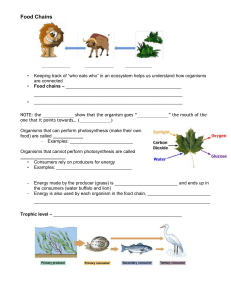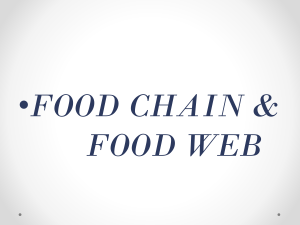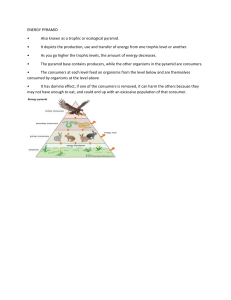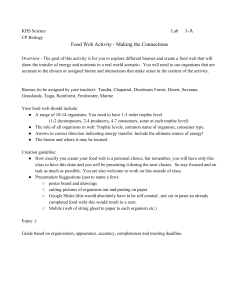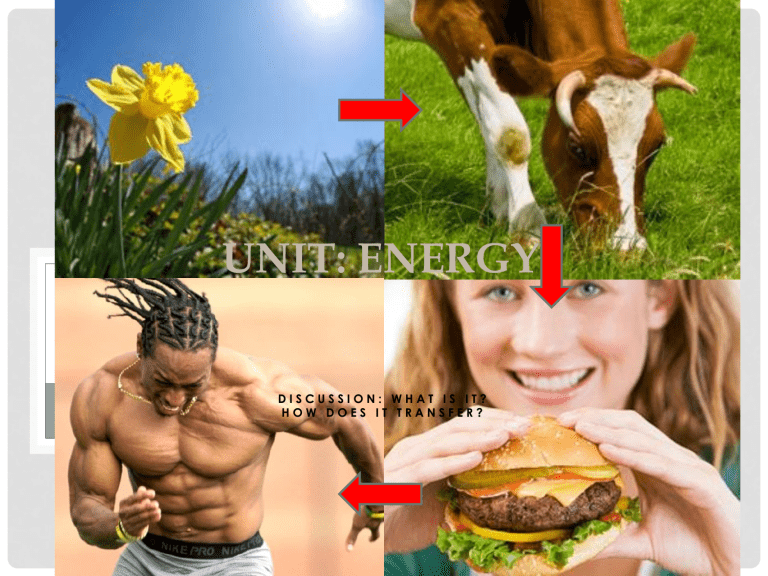
UNIT: ENERGY DISCUSSION: WHAT IS IT? HOW DOES IT TRANSFER? OBJECTIVES • Describe what “Energy” is in biology? • Describe how energy flows in an ecosystem. • Explain why only 10% of energy is transferred from one trophic level to the next. • Describe the difference between a herbivore, a carnivore, a detritivore, a decomposer, and an omnivore. VOCABULARY • • • • • Producer Consumer Decomposer Trophic level Energy pyramid INTERDEPENDENCY IN ECOSYSTEMS • Organisms in an ecosystem are interconnected. • “Connected together” • One of the most fundamental ways is how they participate in the cycling of matter & energy. • These are the relationships that describe who becomes another organism’s lunch. WHAT IS ENERGY? • Energy is the ability to do work. • What is work? Thinking Growth • Physics = Force over a distance Mitosis/Meiosis • Biology = All the forces that make life Physical Exercise possible. Digesting Food • What ways do we do “work” Active Transport biologically? Chemical Reactions Fighting Disease STATES & FORMS OF ENERGY • Energy exists in one of 2 states • Potential = Stored energy that will be used later • Kinetic = Energy doing work… causing things to happen • Energy exists in many forms between these states. • • • • • • • Mechanical Thermal Electrical Nuclear Light Sound Radiation CONSTRAINTS ON ENERGY • Energy has the ability to change between forms. • Mechanical thermal (releases heat) • Nuclear electrical (nuclear power plants) • Energy is bound by the laws of Thermodynamics. • 1st Law of Thermodynamics = all energy in existence is all there ever was or will be (it cannot be created nor destroyed, just converted between forms) • 2nd Law = Entropy = Disorder increases over time. • A small fraction of energy is always lost to the environment in any reaction as unrecoverable heat. • Energy is mostly able to be measured by its heat. • We use the unit calories = the energy required to raise the temperature of water by 1°C ENERGY • Energy is necessary for life, but how do we get what we need? • Why do you think organisms eat each other? • It’s to gain energy. • As one organism eats another it consumes all the energy from that organism that is stored as proteins, sugars, nucleic acids, and fats. • This energy is mostly dedicated to supporting life. • But most of this energy originates far from Earth. FLOW OF ENERGY • Most energy that is used in food chains originates from the sun. • Photosynthetic organisms, such as plants and algae, trap and change light energy from the sun into chemical energy in the form of the sugar, glucose. FLOW OF ENERGY • The basic flow of energy is: • SUNPRODUCERSCONSUMERSDECOMPOSERS • The photosynthetic organisms are producers; the organisms that trap sunlight and convert it into usable energy • basic food source for an ecosystem. • Consumers are organisms that eat other organisms instead of producing their own food. • But it usually is more complex with many intermediate steps. PRODUCERS • The most numerous of all organisms on Earth are producers, those organisms that harness the energy in sunlight and store it in the bonds of sugars. • Producers are called AUTOTROPHS = make their own energy. • This energy is then used as food to fuel the life of these organisms. • Those include all plants, many algae, and some bacteria. Light absorbed Photosynthesis stores the energy absorbed from the sun in the bonds of sugars, like glucose. CONSUMERS • Plants, essentially, make their own food. • Animals can’t. • How do we, and just about every other organism, obtain the energy we need? • We are consumers, organisms that have to eat other organisms to obtain the chemical energy for life. THERE ARE MANY NAMES FOR CONSUMERS • Autotrophs, like plants, make their own food. • Heterotrophs = organisms that eat other organisms to obtain energy. • • • • • • Primary consumers: Eat Producers = Herbivores Secondary consumers: Eat primary consumers Carnivores = eat other heterotrophs Omnivores = eat both plants and animals Detritivore = digests dead organisms. Decomposers = break down organic substances (decayed matter) TROPHIC LEVELS • Each step in the transfer of energy through an ecosystem is called a trophic level. • In an ecosystem, energy flows… • • • • …from the sun… …to producers… …to consumers… …to decomposers. TROPHIC LEVELS TROPHIC LEVELS Food Chains • In ecosystems, energy flows from one trophic level to the next, forming a food chain. • A food chain is a direct passage of energy through interconnected organisms. Food Webs • In most ecosystems, energy does not follow a simple food chain. Energy flow is much more complicated. • Ecosystems almost always have many more species than a single food chain has. In addition, most organisms eat more than one kind of food. • A complicated, interconnected group of food chains is called a food web. FOOD CHAIN Click above to play the video. FOOD WEB IN ANTARCTIC ECOSYSTEM Take a look at the food web at the back of the room ENERGY PYRAMID This is an energy pyramid. It diagrams the usable energy in a food chain through the various trophic levels • Energy is stored at each trophic level in a food chain. • When an animal eats food, it consumes all the energy from the food. • Why is this in the shape of a pyramid? • Because there is fewer amounts of energy at each level. ENERGY ENERGY ENERGY TRANSFER THROUGH TROPHIC LEVELS ENERGY LOSS IN FOOD CHAINS • When on organism eats another, what happens to it? • If you eat a 1000-calorie burger how much of the energy did you use for your life? • You used roughly 100 calories out of the 1000-calorie burger to help you stay you. • This is called the 10% rule and governs most food chains. • Roughly, only 10% of the energy present in each trophic level is available for the next trophic level. • Where does the other 90% go? • Used for metabolism… the sum of all chemical reactions. • Lost as heat. • What does this 10% mean? • The 10% becomes part of the organism, which is then made available to the next level up the food chain. AMOUNT OF ENERGY AT FOUR TROPHIC LEVELS 10% Energy TOP CARNIVORES/ 90% of the OMNIVORES energy CARNIVORES lost as heat HERBIVORES PRIMARY PRODUCERS VISUAL CONCEPT: ENERGY PYRAMID Click above to play the video. SUMMARY • Know: • • • • • The roles in a food chain. What a trophic level is. What a food chain is. What a food web is. How to track energy through a food chain/web. • HW: • Complete the worksheet. • Identify Food chains in a food web. • Track energy though successive trophic levels in a food chain.



